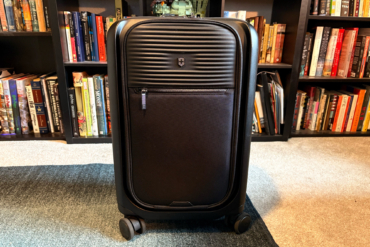You found a great spot to hole up for a few days, but how do you find off-grid electricity to power your RV office? Here, we evaluate methods to make, store, and manage electricity while boondocking.
Most RVs have only one or two deep-cycle batteries tasked to operate slide-outs, awnings, landing gear, leveling jacks, and a few lights. Ask too much of them, and they may not last a weekend. For the working professional, reliable electricity isn’t a luxury — it’s a necessity.
Off-Grid RV Electricity: Fire Up the Generator
For years, the gas-powered generator was the bane of the backwoods: loud, smelly, and prone to failure. A gallon of gasoline yields only enough electricity for a 24-hour camping cycle. While some larger RVs include onboard generators, most people in small motorhomes and trailers opt for a portable unit.
The latest generators bear little resemblance to their predecessors. Models like the Cummins Onan P2500i and P4500i fit in the small storage spaces of most RVs and are easy to transport, operate, and maintain.
Our electrical demands have evolved over the years. So newer units include advanced features like remote starters, voltage displays, and automatic throttle control to maximize fuel efficiency and reduce noise levels.
It seems ill-advised to plug something as delicate as a laptop into a gas-powered machine. But newer units generate clean, sine-wave electricity safe for all devices.
If you live off the beaten path with much frequency, a generator will likely top your gear list.
Soak Up the Sun: Solar Electric RV Options
You can’t beat free electricity. With no need for fuel or upkeep, the silent operation of a solar panel retains the blissful tranquility of your remote hideout. If there’s a downside other than the occasional cloudy day, it’s the initial outlay of cash. The more power you require, the higher the price you pay for it.
Before you dive into a solar-powered solution, you must first calculate your wattage needs, including all of the many devices you plan to power.
How long you intend to draw power from a single charge influences the capacity of the battery, or batteries, you need. The power output of the panel array determines the speed at which the batteries recharge. Inverters and controllers manage the delivery of power, in and out, to meet the surge and sustained wattage currents of your RV’s appliances, lights, and outlets.
It seems like a simple solution, but solar tech is a rabbit hole from which many RV owners never return. High-wattage systems, typically hard-mounted to the roof, generate sufficient energy to run small air conditioners, laptops, and even TVs. But they’re complicated to install — and expensive. Expect to pay at least $3,000 for that level of self-contained power production for a large travel trailer or motorhome.
To streamline sun power, manufactures like Go Power! sell ready-to-install kits complete with solar panels, inverters, connectors, controllers, and batteries. The brand’s website includes a wattage calculator to help guide buyers to the best solution for their individual needs.
Maybe you’re not ready to commit to a comprehensive built-in system. Well, a small plug-and-play kit with a dedicated power pack might be the way to go. Portable panels like the Goal Zero Boulder 100W produce just enough wattage to trickle-charge an onboard RV battery or the brand’s own power packs.
Portable Power Packs: Batteries for Camping
The advent of lithium batteries created a growing number of convenient power products with superb RV utility. Brands like Xantrex make high-capacity battery systems with enough juice to keep a laptop running for several days.
Unlike a hard-mounted RV battery, they are easy to move from one vehicle to the next, or under a shady tree while you crank out a few emails. As a backup or alternative to a gas generator, power packs require no maintenance other than the occasional recharge.
To keep them topped off, most units pair to medium-size solar panels. Options like the Go Power GP-FLEX-100 provide flexible, ultra-portable charging solutions. Whether you travel in a Subaru with a rooftop tent or a full-size travel trailer, a power pack of any size always earns its keep.
Assuage the Surge: Protect Your RV Batteries
It’s fun to camp far from other people. But the occasional RV park stopover offers a chance to empty storage tanks, access free Wi-Fi, and plug into 30- or 50-amp shore power.
But easy access to electricity presents dangerous potential. Without a surge protector for your RV, a drop in current or a heavy jolt could fry your entire electronic ecosystem. It’s not uncommon to hear of RV owners losing expensive equipment. Air-conditioning units, kitchen appliances, laptops, entertainment systems, all of the delicate circuits within an RV’s control panel — nothing is safe.
For the power pedants, the Watchdog 30/50 Amp Smart Surge Protector with Auto Shutoff pairs to your smartphone so you can assess troublesome currents in real time at a glance. If the plug detects a disturbance in the Force, it immediately isolates your RV. Nobody wants to buy a $275 power plug, but it could save you thousands of dollars in the long run.
Once you select the best solution for your needs, you have the power to stay in the wilderness for days on end while still making paychecks. And that’s what it’s all about.
This article is sponsored by Go RVing. Check out RV travel ideas, news, and dealer information at gorving.com.








